
The award is intended to highlight cutting edge infrastructure practices that drive sustainability including those that address environmental, social, or emerging technology challenges, or the growing complex environments that infrastructure are expected to operate in. Phoenix-area infrastructure professionals from public, private, non-profit, and academic organizations are invited to submit their nominations. Nominations are limited to one per organization. Nomination packages will be reviewed by the Metis Center faculty. Awardees will receive a plaque acknowledging the innovative efforts of the organization on the nominated project. For reference, the previous Sustainable Infrastructure Awardees are listed below.
This year we are excited to expand the awards to two infrastructure categories: 1) Built (Gray), and, 2) Ecological, recognizing that sustainable and resilient infrastructure often take on aspects of either, or hybrid forms.
Nomination packages are brief (about two pages) and should conform to the precise requirements described within the form. In general this includes the project champion/contact, a short description of the project, the challenges that were addressed, and the sustainability outcome. It is due by 5pm MST on Friday, October 28, 2022. The nomination package should be uploaded as a single PDF file and include the completed two page nomination form plus any supplemental material (project photos, letters of support, and project documentation). Supplemental material is not required.
 |
Metis Center 2022 Sustainable Infrastructure Awards Flyer |
 |
Nomination Fillable Form |
 |
Submission Package Upload |
The Metis Center for Infrastructure and Sustainable Engineering at Arizona State University is pleased to announce the awardees of the Sustainable Infrastructure Awards. The award highlights cutting edge infrastructure practices that drive sustainability including those that address environmental, social, or emerging technology challenges, or the growing complex environments where infrastructure is expected to operate. Arizona infrastructure professionals from public, private, non-profit and academic organizations are invited to submit their nominations.
2022 Sustainable Infrastructure Awardees
Paideia Academies
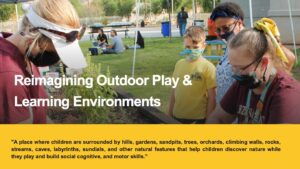 In 2019, Paideia Academies ambitiously set out to address the challenges of schoolyard exposures to heat and air pollution, and to manage stormwater through revitalization of their playspaces as natural play and learning environments (NPLE). In 2021, after data collection, co-creation of designs with the community, funding challenges, and various iterations of plans, the school broke ground to create an NPLE. The schoolyard is now a more naturalized landscape full of compelling nature-based play and learning opportunities, ready to be discovered by children. In these spaces, children are surrounded by hills, gardens, bioswales, native trees and plants, trees, orchards, climbing vines, rocks, and streams that help them discover nature while they play and build social cognitive, and motor skills. Importantly, the infrastructure provides abundant shade, growing more each year, hedges for protection from heat, traffic pollution, and noise, and bioswales to manage stormwater runoff from South Mountain. A new school garden sanctuary provides food and additional learning experiences. These outdoor environments are also part of the school’s environmental and sustainability curriculum. Overall, Paideia has provided a prominent example of sustainable infrastructure implementation that yields educational and ecological benefits on their schoolyards among complex environmental, social, and infrastructural challenges. They are grateful for support from the Healthy Urban Environments Initiative and Knowledge Exchange for Resilience at ASU that has helped foster the discovery of new knowledge surrounding NPLEs.
In 2019, Paideia Academies ambitiously set out to address the challenges of schoolyard exposures to heat and air pollution, and to manage stormwater through revitalization of their playspaces as natural play and learning environments (NPLE). In 2021, after data collection, co-creation of designs with the community, funding challenges, and various iterations of plans, the school broke ground to create an NPLE. The schoolyard is now a more naturalized landscape full of compelling nature-based play and learning opportunities, ready to be discovered by children. In these spaces, children are surrounded by hills, gardens, bioswales, native trees and plants, trees, orchards, climbing vines, rocks, and streams that help them discover nature while they play and build social cognitive, and motor skills. Importantly, the infrastructure provides abundant shade, growing more each year, hedges for protection from heat, traffic pollution, and noise, and bioswales to manage stormwater runoff from South Mountain. A new school garden sanctuary provides food and additional learning experiences. These outdoor environments are also part of the school’s environmental and sustainability curriculum. Overall, Paideia has provided a prominent example of sustainable infrastructure implementation that yields educational and ecological benefits on their schoolyards among complex environmental, social, and infrastructural challenges. They are grateful for support from the Healthy Urban Environments Initiative and Knowledge Exchange for Resilience at ASU that has helped foster the discovery of new knowledge surrounding NPLEs.
City of Phoenix: Electric Vehicle Charging at Public Libraries
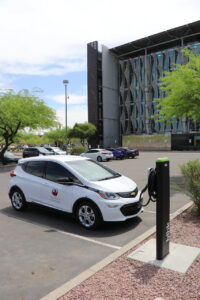 This project consisted of the installation of 20 Blink Level 2 dual port charging stations at ten (10) Phoenix Public Libraries (Juniper, Ironwood, Yucca, Palo Verde, Saguaro, Acacia, Desert Broom, Ocotillo, and Harmon). This project results in EV charging access availability at all Phoenix public libraries. Additional transformers and electrical panels were installed or upgraded to provide the required electrical power needs. The addition of these EV charging stations helps meet the City’s Climate Action Plan, and Transportation Electrification Action Plan goals to be carbon neutral by 2050 and to install 500 EV charging stations on City managed properties by 2030. The installation of these EV chargers will help meet the growing charging demand needed by EVs and provide additional public EV charging access in equity focused areas that are underserved and underinvested with resources.
This project consisted of the installation of 20 Blink Level 2 dual port charging stations at ten (10) Phoenix Public Libraries (Juniper, Ironwood, Yucca, Palo Verde, Saguaro, Acacia, Desert Broom, Ocotillo, and Harmon). This project results in EV charging access availability at all Phoenix public libraries. Additional transformers and electrical panels were installed or upgraded to provide the required electrical power needs. The addition of these EV charging stations helps meet the City’s Climate Action Plan, and Transportation Electrification Action Plan goals to be carbon neutral by 2050 and to install 500 EV charging stations on City managed properties by 2030. The installation of these EV chargers will help meet the growing charging demand needed by EVs and provide additional public EV charging access in equity focused areas that are underserved and underinvested with resources.
Hunter Contracting Co: 7th Street and Salt River Bridge Emergency Repair
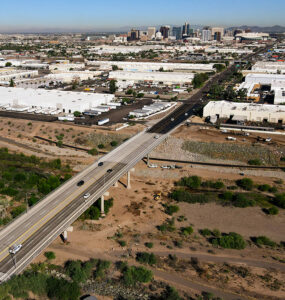 Hunter committed to the City of Phoenix that the 7th Street and Salt River bridge would be open for traffic within six months following a fire that caused extensive damage. This commitment made schedule coordination a priority from day one of the design. In addition, the project included multiple utilities that had to be in the bridge design. The coordination with the utility companies started early in the project. Hunter continued coordinating with the utility companies throughout the project to ensure their schedules stayed on track to meet that six-month commitment. To save the City of Phoenix money and limit waste, the design used as much of the existing bridge as possible.
Hunter committed to the City of Phoenix that the 7th Street and Salt River bridge would be open for traffic within six months following a fire that caused extensive damage. This commitment made schedule coordination a priority from day one of the design. In addition, the project included multiple utilities that had to be in the bridge design. The coordination with the utility companies started early in the project. Hunter continued coordinating with the utility companies throughout the project to ensure their schedules stayed on track to meet that six-month commitment. To save the City of Phoenix money and limit waste, the design used as much of the existing bridge as possible.
While it first presented a challenge, we were able to work through the design to reuse one of the piers. The New American Association of State Highway and Transportation Officials (AASHTO) code required a thicker bridge deck than was on the existing undamaged section of the bridge. To comply with this new AASHTO code, we reduced the bearing pad thicknesses, thus keeping the existing pier and still connecting to the undamaged section of the bridge. We also removed the material to the ground level and used the drilled shafts already in place.
Hunter was able to salvage most of the existing materials, restore the riprap scour protection, restore the river bottom with native species, and recycle the rebar from the bridge demolition. Getting this bridge operational was critical to the sustainability of this area. By making the unique approach of performing a design-build project under a JOC contract, and everyone involved committing that time was of the essence, the bridge was safely re-opened in only six months.
Hunter Contracting Co. : Desert Sky Park Phase 1
 With a population over 200,000 and no public area for outdoor sports, the Gilbert community was in desperate need of multi-purpose fields. The design of Desert Sky Park Phase 1 provides 30 acres of fields and fitness for Gilbert communities. This phase one includes four multi-use fields, Musco field lighting, landscape and irrigation, a restroom and office building, a 3.5-acre lake that is also used for irrigating the fields, jogging trails, an extreme Ninja-Warrior-type fitness course, a playground, picnic ramadas, large-scale event parking, plaza area, shade structures, and a smart bench for recharging electronics. This project involved intense coordination and collaboration with the Flood Control District of Maricopa County (FCDMC), Town of Gilbert, Salt River Project (SRP), Southwest Gas, Union Pacific Railroad (UPRR), and HOAs to satisfy everyone’s requirements.
With a population over 200,000 and no public area for outdoor sports, the Gilbert community was in desperate need of multi-purpose fields. The design of Desert Sky Park Phase 1 provides 30 acres of fields and fitness for Gilbert communities. This phase one includes four multi-use fields, Musco field lighting, landscape and irrigation, a restroom and office building, a 3.5-acre lake that is also used for irrigating the fields, jogging trails, an extreme Ninja-Warrior-type fitness course, a playground, picnic ramadas, large-scale event parking, plaza area, shade structures, and a smart bench for recharging electronics. This project involved intense coordination and collaboration with the Flood Control District of Maricopa County (FCDMC), Town of Gilbert, Salt River Project (SRP), Southwest Gas, Union Pacific Railroad (UPRR), and HOAs to satisfy everyone’s requirements.
The shaded playground area extends the fun of the park and encourages good physical health. The park is the only fitness-based playground in Gilbert with Ninja-Warrior-type equipment to encourage visitors to have fun while exercising. While this type of equipment is becoming more popular, most places have the smaller-sized version meant for younger children. Desert Sky Park incorporates the larger-sized version to emphasize you are never too old to have fun being healthy. There are also multiple playground features for younger children under the same shade structure as the course so visitors of all ages can be active together. Wanting to promote this active, healthy lifestyle to fit different schedules, the Ninja-Warrior course and playground have shade structures to protect from the day’s UV rays as well as lights for using the equipment in the evening. Walking and running paths promote fitness while visitors enjoy the sights and sounds of various play areas and the reclaimed water filled lake. In addition to community members enjoying free time and exercising, the Public Safety Training Facility neighbors the park and uses the park for training, fitness, and relaxation.
Stanley Consultants: Peoria’s First ASR Well
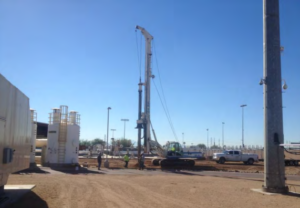 With a deep understanding of the importance of both water conservation and sustainability, the City of Peoria is continually making modifications and improvements to its effluent reuse system. One of the most recent improvements is the Butler Water Reclamation Facility Aquifer Storage and Recovery Well, which helps keep valuable water resources under the City’s feet rather than conveying it to a regional recharge facility.
With a deep understanding of the importance of both water conservation and sustainability, the City of Peoria is continually making modifications and improvements to its effluent reuse system. One of the most recent improvements is the Butler Water Reclamation Facility Aquifer Storage and Recovery Well, which helps keep valuable water resources under the City’s feet rather than conveying it to a regional recharge facility.
This marks the City’s first ASR well, but not its last. Direct reuse and aquifer recharge of reclaimed water is essential for Peoria’s sustainability and water conservation. The positive results have prompted the City to begin planning for additional ASR wells . In the meantime, the first well is operating consistently and meeting the City’s expectations.
The new ASR well is a sustainability and economical win for the City. Previously much of the Butler WRF treated effluent had to be pumped off site which caused the City to sacrifice up to 60 percent of the available recharge credits. With the well located adjacent to the treatment facility the City now receives 100 percent of the recharge credit for each gallon it injects into the aquifer. The well is permitted to recharge 1,330 acre feet per year (1.2 million gallons per day) Following the assured and adequate water supply program (ADWR), for every 1000 gallons injected, 950 gallons can be withdrawn as new drinking water resources. The convenient siting of the well on the treatment plant grounds required no property acquisition and all maintenance and oversight can be performed by staff already on site.
WOODPATEL Civil Engineers: Culdesac Tempe: The first car-free neighborhood built from scratch in the US
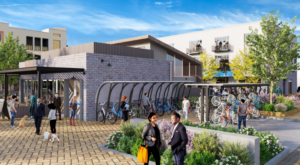 Culdesac builds neighborhoods for people, not cars. Obsessed with the future of cities and transportation the project is led by a technology driven developer and property manager- this car free neighborhood is designed for shared mobility (walking, biking, ride/bikeshare, e-scooters), rather than private vehicles.
Culdesac builds neighborhoods for people, not cars. Obsessed with the future of cities and transportation the project is led by a technology driven developer and property manager- this car free neighborhood is designed for shared mobility (walking, biking, ride/bikeshare, e-scooters), rather than private vehicles.
The site located adjacent to the Smith-Martin Apache Blvd light rail station is 17 acres of contiguous urban infill in north Tempe. The sellers have worked on this assemblage since 2003, and it is part of a larger master planned urban infill called Eastline.
The total development will embody 750 residential compact and elegant rent-able units with abundant shared green space; 16k sf of vibrant retail lifestyle driven amenities: a restaurant, coffee shop, co-working space, bike shop, gym and more.
Infrastructure and tech enabled property managment services are designed for convenient resident access to rideshare, bikeshare, autonomous vehicles and property management.
The site connects residents to public transit, retail, Arizona State University, downtown Phoenix, and the airport. The 1000-person scale of the neighborhood allows us to take a more holistic approach to the resident experience. One example: instead of people having private guest rooms (which are typically only used a few nights a year), visitors can stay in bookable guest suites place throughout the neighborhood.
Arizona Department of Transportation: Highway Stormwater Pumps - Total Systems Reliability Project
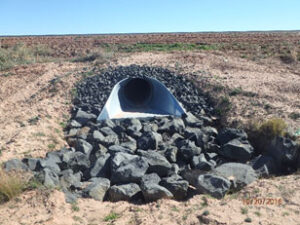 Pumping station operators have tacit knowledge of the causes and effects of pump failures from their experience maintaining the hardware, but there is limited knowledge of how age, design, hardware condition, and environmental conditions contribute to affecting performance. Currently, ADOT pump operators use an Excel spreadsheet to assess “criticality” of pumping stations which relies entirely on manual inputs of current status data and a custom percent uptime metric that describes overall system status. The current Excel tool is critical for making day-to-day decisions about where to prioritize resources. However, it provides no predictive capabilities for how the hardware might perform into the future and where to prioritize preventative maintenance and capital improvements.
Pumping station operators have tacit knowledge of the causes and effects of pump failures from their experience maintaining the hardware, but there is limited knowledge of how age, design, hardware condition, and environmental conditions contribute to affecting performance. Currently, ADOT pump operators use an Excel spreadsheet to assess “criticality” of pumping stations which relies entirely on manual inputs of current status data and a custom percent uptime metric that describes overall system status. The current Excel tool is critical for making day-to-day decisions about where to prioritize resources. However, it provides no predictive capabilities for how the hardware might perform into the future and where to prioritize preventative maintenance and capital improvements.
The project developed a dynamic reliability analysis decision-support tool to provide real-time information to operators considering hardware and environmental conditions to prioritize maintenance and rehabilitation. The tool is based on state-of-the-art statistical reliability methods. The tool is positioned to reduce costs associated with maintenance and rehabilitation of pumps while increasing reliability by identifying which hardware should be serviced ahead of failure. Since pumping stations are vulnerable to failure under heavy storm events, the tool will evaluate outcomes under different precipitation magnitude scenarios.
Gannett Fleming, Inc.: PHX Sky Train Stage 2 Automated People Mover System
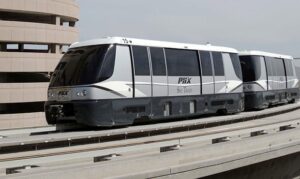 The existing 3.2-mile PHX Sky Train® line connects the airport’s Valley Metro Rail Station to airport terminals. The Stage 2 extension, connecting the terminals to the Rental Car Center and Ground Transportation Center at 24th Street, will be a powerful catalyst for long-term airport growth and adjacent private development. It also supports the airport’s sustainability goals, helping reduce the daily vehicle count by 20,000. Prior to the COVID-19 pandemic, PHX was anticipated to serve 58 million travelers in 2024, up from 44 million in 2017. The opening of PHX Sky Train® Stage 2 is scheduled for 2022.
The existing 3.2-mile PHX Sky Train® line connects the airport’s Valley Metro Rail Station to airport terminals. The Stage 2 extension, connecting the terminals to the Rental Car Center and Ground Transportation Center at 24th Street, will be a powerful catalyst for long-term airport growth and adjacent private development. It also supports the airport’s sustainability goals, helping reduce the daily vehicle count by 20,000. Prior to the COVID-19 pandemic, PHX was anticipated to serve 58 million travelers in 2024, up from 44 million in 2017. The opening of PHX Sky Train® Stage 2 is scheduled for 2022.
Gannett Fleming is the fixed-facilities designer of record for PHX Sky Train® Stage 2, providing guideway and support structure design from concept to completion. The project’s dual-lane guideway includes two depressed sections that will pass through underpasses built 19 to 26 feet below ground to carry trains below two future aircraft taxiways. The undercrossing structures were designed to facilitate taxiway construction without affecting train operations. The Stage 2 guideway will serve three new stations: the Rental Car Center Station, built into the upper level of the existing structure; the 24th Street Station, which will connect to nearby parking and ground transportation facilities and planned commercial development; and a station that will serve the airport’s future West Terminal. Design work at the third station includes splitting the guideway to accommodate a central platform and future terminal connections.
Arizona Department of Transportation: Laguna Creek Bridge Scour Remediation
 The Laguna Creek Bridge is within the boundaries of the Navajo Nation Reservation. This site is approximately 25 miles east of the town of Kayenta, Arizona. The original bridge structure was constructed in 1961 by the United States Department of Interior. In 1984, the original bridge was retrofitted with barriers. During the period from 2004 to 2008, bridge inspections identified excessive scour at both of the pier locations. In 2012, a replacement bridge was constructed just to the south of the previously existing bridge structure. Bridge abutments repairs and countermeasures were recommended but were found to be insufficient to address the current problem. Since then, inspection efforts continued to identify and monitor the accelerated meandering of the wash and subsequent undercutting of the abutment fill. The goal of the project was to provide protection of the existing bridge and roadway against the effects of local scour and severe channel meandering just upstream and downstream of the bridge crossing.
The Laguna Creek Bridge is within the boundaries of the Navajo Nation Reservation. This site is approximately 25 miles east of the town of Kayenta, Arizona. The original bridge structure was constructed in 1961 by the United States Department of Interior. In 1984, the original bridge was retrofitted with barriers. During the period from 2004 to 2008, bridge inspections identified excessive scour at both of the pier locations. In 2012, a replacement bridge was constructed just to the south of the previously existing bridge structure. Bridge abutments repairs and countermeasures were recommended but were found to be insufficient to address the current problem. Since then, inspection efforts continued to identify and monitor the accelerated meandering of the wash and subsequent undercutting of the abutment fill. The goal of the project was to provide protection of the existing bridge and roadway against the effects of local scour and severe channel meandering just upstream and downstream of the bridge crossing.AZTEC Engineering Group, Inc: PVGRAd – A novel software for grading and structural optimization of photovoltaic solar power plants
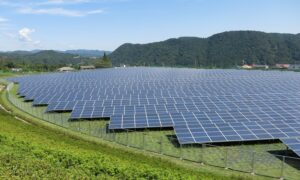 AZTEC Engineering developed a very unique and proprietary simulation software for the most favorable design of ground-based photovoltaic solar power systems through optimization of grading and steel costs. PVGRAd is a novel 3D simulation tool developed entirely in AZTEC’s headquarters in Phoenix that combines the project site digital terrain model and the proposed photovoltaic solar power system layout to produce the optimized civil and structural design for the project automatically, based on a limited number of design parameters.
AZTEC Engineering developed a very unique and proprietary simulation software for the most favorable design of ground-based photovoltaic solar power systems through optimization of grading and steel costs. PVGRAd is a novel 3D simulation tool developed entirely in AZTEC’s headquarters in Phoenix that combines the project site digital terrain model and the proposed photovoltaic solar power system layout to produce the optimized civil and structural design for the project automatically, based on a limited number of design parameters.Banner Health, Facilities Operations: Remote Operations Center
 In 2017, Banner leveraged experience and lessons learned by designing and developing a centralized Remote Operations Center (ROC). The ROC would be outfitted with the technology and skill sets needed to drive an enterprise-level energy program with an operational focus on achieving and sustaining energy savings indefinitely. Additionally, the ROC would leverage a cultural shift that emphasizes the importance of savings by making energy goals a part of everyone’s annual performance review. This tactic created shared accountability for sustained performance among all facilities operations staff.
In 2017, Banner leveraged experience and lessons learned by designing and developing a centralized Remote Operations Center (ROC). The ROC would be outfitted with the technology and skill sets needed to drive an enterprise-level energy program with an operational focus on achieving and sustaining energy savings indefinitely. Additionally, the ROC would leverage a cultural shift that emphasizes the importance of savings by making energy goals a part of everyone’s annual performance review. This tactic created shared accountability for sustained performance among all facilities operations staff.Hunter Contracting: MAR 5 & Gila River Interpretive Trail
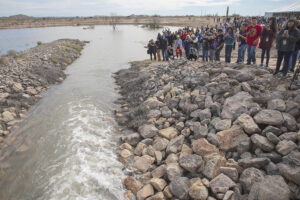 The MAR 5 site was chosen to begin restoring a healthy underground aquifer. It was decided the area above the aquifer would be used to create a place where members of the Gila River Indian Community could come to reconnect to the water that is such an integral part of their heritage. Neill + Young Associates designed what is now known as the Gila River Interpretive Trail, then Hunter Contracting set to work building the site. A one-mile walking trail allows visitors to enjoy nature. Ramada areas on the east side provide ample space for celebrations. The area on the west side is for artisans to do activities such as basket weaving and to demonstrate those skills to future generations. The MAR 5 site contains native plants such as cattails and willow that will flourish and artisans can harvest the materials for their basket weaving. The site will also have educational classes and guided tours.
The MAR 5 site was chosen to begin restoring a healthy underground aquifer. It was decided the area above the aquifer would be used to create a place where members of the Gila River Indian Community could come to reconnect to the water that is such an integral part of their heritage. Neill + Young Associates designed what is now known as the Gila River Interpretive Trail, then Hunter Contracting set to work building the site. A one-mile walking trail allows visitors to enjoy nature. Ramada areas on the east side provide ample space for celebrations. The area on the west side is for artisans to do activities such as basket weaving and to demonstrate those skills to future generations. The MAR 5 site contains native plants such as cattails and willow that will flourish and artisans can harvest the materials for their basket weaving. The site will also have educational classes and guided tours.SDB Contracting Services: ASU – PTS Vehicle Charging Stations
 This project consisted of installation of more than 22 Chargepoint Level II Dual-Port charging stations at parking structures throughout the ASU parking facilities at Tempe, Polytechnic, West and Downtown campuses. The addition of transformers and electrical panels were necessary to allow for more energy efficient and reliable charging options for a wider range of electric vehicles and allow for future stations to be added without significant cost. Now that this initial investment has been made, the minimization of the carbon footprint related to use of electric vehicles and independence from fossil fuels helps move the community toward more sustainable options for transit and enable a wide range of people to access the campus in electric vehicles.
This project consisted of installation of more than 22 Chargepoint Level II Dual-Port charging stations at parking structures throughout the ASU parking facilities at Tempe, Polytechnic, West and Downtown campuses. The addition of transformers and electrical panels were necessary to allow for more energy efficient and reliable charging options for a wider range of electric vehicles and allow for future stations to be added without significant cost. Now that this initial investment has been made, the minimization of the carbon footprint related to use of electric vehicles and independence from fossil fuels helps move the community toward more sustainable options for transit and enable a wide range of people to access the campus in electric vehicles.Stacy and Witbeck / Sundt, A Joint Venture: Gilbert Road Light Rail Extension
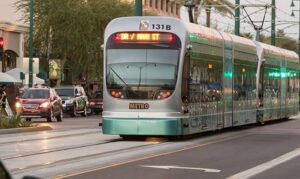 The 1.9-mile Gilbert Road Light Rail project in Mesa, Arizona, consists of two stations, a park-and-ride and the nation’s first four-way roundabout across light rail tracks. The $184 million project will provide the ability to draw more light-rail passengers from the East Valley and bring greater development opportunities to central Mesa. This project reached for sustainable goals through decreasing air quality due to the installation of the light rail, using an aggregate supplier that was within five miles of the construction zone, implementing a thorough recycling program, and creating a highly effective storm water pollution prevention plan (SWPPP).
The 1.9-mile Gilbert Road Light Rail project in Mesa, Arizona, consists of two stations, a park-and-ride and the nation’s first four-way roundabout across light rail tracks. The $184 million project will provide the ability to draw more light-rail passengers from the East Valley and bring greater development opportunities to central Mesa. This project reached for sustainable goals through decreasing air quality due to the installation of the light rail, using an aggregate supplier that was within five miles of the construction zone, implementing a thorough recycling program, and creating a highly effective storm water pollution prevention plan (SWPPP).Valley Metro: 50th Street/Washington Station
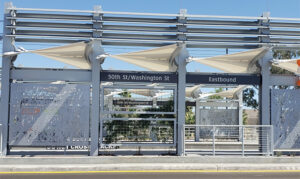 Valley Metro’s 50th Street/Washington Station is a new addition to the light rail that will serve Ability360 and the surrounding community. This is the first light rail station to be added to the existing light rail line (rather than added as a line extension) and also the first light rail project funded entirely by the City of Phoenix Transportation 2050 funds. This new station serves people by considering the disability community that will be utilizing the station, benefits the economy by providing increased access to 55 businesses in the nearby industrial park, benefits the environment by mitigating heat and benefits regional air quality.
Valley Metro’s 50th Street/Washington Station is a new addition to the light rail that will serve Ability360 and the surrounding community. This is the first light rail station to be added to the existing light rail line (rather than added as a line extension) and also the first light rail project funded entirely by the City of Phoenix Transportation 2050 funds. This new station serves people by considering the disability community that will be utilizing the station, benefits the economy by providing increased access to 55 businesses in the nearby industrial park, benefits the environment by mitigating heat and benefits regional air quality.

